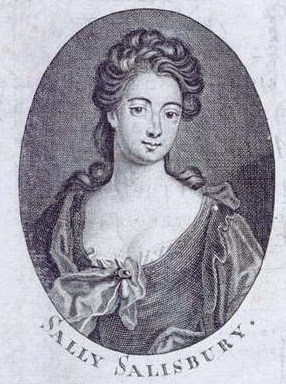
Wikimedia Commons
Sally Salisbury (c. 1692 – 1724) was the adopted name of a prostitute who worked in early 18th-century London, celebrated for her beauty and her wit. She achieved notoriety after stabbing and mortally wounding one of her aristocratic clients during an argument.
Born Sarah Pridden, Sally was apprenticed to a seamstress in Aldgate at the age of nine, but soon ran away and took to life on the streets of the slum district of St Giles. She supported herself by various forms of street trading, and became well known in London as:
But her pamphlet sales were merely a sideline to her more lucrative trade, which was charging the boys half a crown for an hour of her time.[1][a]Half a crown represented about two day’s wages for a general labourer in the early 18th century.[2]
Celebrity prostitute
At the age of fifteen Sally was recruited by Mother Wisebourn, whose house in Covent Garden was one of the most exclusive and expensive brothels of the time.[3] She attracted many aristocratic clients, among them the Secretary of State, Viscount Bolingbroke, willing to pay “the highest price for the greatest pleasure”.[4] Her other patrons included the Duke of Richmond, the poet and diplomat Matthew Prior, Nell Gwyn’s son the Duke of St Albans, and even it was rumoured the future George II.[5]
Sally adopted the name she became known by after an acquaintance pointed out a resemblance between her and the Countess of Salisbury.[3]
Stabbing
In December 1721 Sally had a drunken quarrel with one of her clients, the Honourable John Finch, son of the Countess of Winchelsea, in the Three Tuns tavern in Chandos Street, Covent Garden. She picked up the knife that had been provided for cutting the bread roll, and stabbed him in the chest. Apparently immediately remorseful, she called for a surgeon before asking Finch to forgive her, to which he replied “Yes, I do, and can die with pleasure by your hand”.[3] Sally was arrested and remanded in Newgate prison to await trial.[6]
Trial and imprisonment
Sally was charged with attempted murder and tried at the Old Bailey on 24 April 1723. Her lawyer claimed that her act had not been premeditated, and that Finch’s forgiveness should count in her favour;[7] he had not been fatally wounded, and had tried desperately to have the charges against Sally dropped.[6]
The defence also argued that Sally had acted to defend her sister from Finch’s dishonourable amorous intentions.[7] Found guilty of assaulting and wounding Finch, but acquitted of doing so with an intent to murder, she was fined £100 and sentenced to a year in prison.[3]
After serving nine months of her sentence, Sally died of “brain fever brought on by debauch”, almost certainly syphilis,[4] and was buried in the churchyard of St. Andrew, at Holborn.[3]
Notes
| a | Half a crown represented about two day’s wages for a general labourer in the early 18th century.[2] |
|---|
References
Bibliography
This article may contain text from Wikipedia, released under the Creative Commons Attribution-ShareAlike License.
